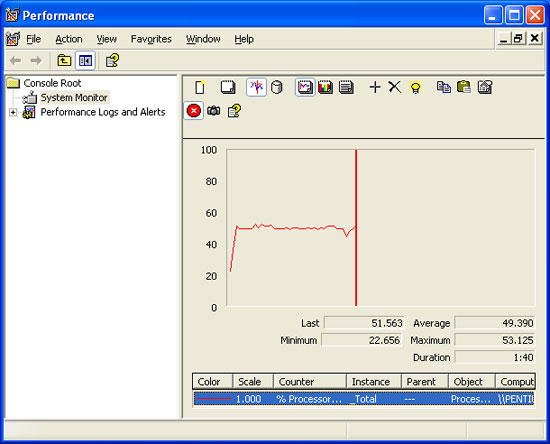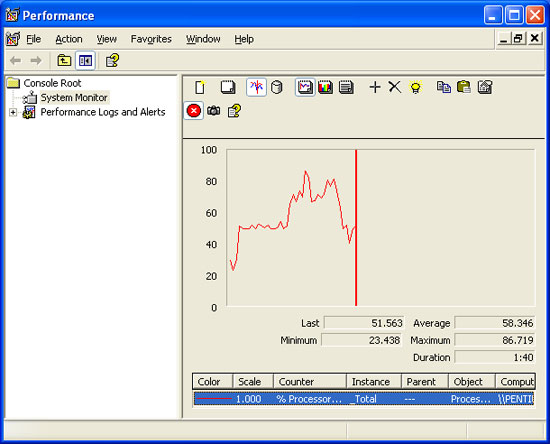Intel's Pentium Extreme Edition 955: 65nm, 4 threads and 376M transistors
by Anand Lal Shimpi on December 30, 2005 11:36 AM EST- Posted in
- CPUs
Multi-core support in Games?
Both Quake 4 and Call of Duty 2 now have SMP support, supposedly offering performance improvements on dual core and/or Hyper Threading enabled processors.
For Call of Duty 2, you simply install the new patch and off you go; SMP support is enabled. To verify, we ran our CoD 2 benchmark and kept a log of the total processor utilization over time. Below is a shot of perfmon with a fresh install of CoD2 (sans SMP patch):
Now, let's look at CoD2 CPU utilization with the SMP patch installed:
We looked at performance at 1024x768 and obviously the higher the resolution, the lesser the impact of a faster CPU (at the same time, the lower the resolution, the greater the impact will be as the game becomes less GPU limited).
To ensure a fair comparison, we tested using the SMP patch and simply disabled SMP manually by setting the r_smp_backend variable to "0". We confirmed that SMP support was actually disabled by running perfmon and measuring CPU utilization.
Surprisingly enough, we actually saw pretty large performance drops in CoD2 with SMP enabled across both AMD and Intel platforms. This is unfortunate, but the withdrawn SMP support of Quake 3 makes it less than shocking. We do expect that things will get better as time goes on.
Quake 4 was a different story; with r_useSMP enabled, we saw some extremely large performance gains with the move to dual core:
The SMP patch either only spawns two threads, or the instruction mix of Quake 4 with the patch does not mix well with Intel's Pentium EE 955. The dual core with Hyper Threading enabled platform didn't do anything at all for performance.
While we're only looking at two games, this is a start for multithreaded game development. You can expect to see a lot of examples where dual-core does absolutely nothing for gaming, but as time goes on, the situation will change.
Both Quake 4 and Call of Duty 2 now have SMP support, supposedly offering performance improvements on dual core and/or Hyper Threading enabled processors.
For Call of Duty 2, you simply install the new patch and off you go; SMP support is enabled. To verify, we ran our CoD 2 benchmark and kept a log of the total processor utilization over time. Below is a shot of perfmon with a fresh install of CoD2 (sans SMP patch):

Now, let's look at CoD2 CPU utilization with the SMP patch installed:

We looked at performance at 1024x768 and obviously the higher the resolution, the lesser the impact of a faster CPU (at the same time, the lower the resolution, the greater the impact will be as the game becomes less GPU limited).
To ensure a fair comparison, we tested using the SMP patch and simply disabled SMP manually by setting the r_smp_backend variable to "0". We confirmed that SMP support was actually disabled by running perfmon and measuring CPU utilization.
| Call of Duty 2 | SMP Disabled | SMP Enabled |
| AMD Athlon 64 FX-57 (2.8GHz) | 80.6 | N/A |
| AMD Athlon 64 X2 4800+ (2.4GHz) | 79.8 | 70.3 |
| AMD Athlon 64 X2 3800+ (2.0GHz) | 78.7 | 68.1 |
| Intel Pentium Extreme Edition 955 (3.46GHz) | 79.8 | 68.4 |
| Intel Pentium Extreme Edition 840 (3.2GHz) | 78.1 | 68 |
| Intel Pentium D 820 (2.8GHz) | 75.6 | 67.1 |
Surprisingly enough, we actually saw pretty large performance drops in CoD2 with SMP enabled across both AMD and Intel platforms. This is unfortunate, but the withdrawn SMP support of Quake 3 makes it less than shocking. We do expect that things will get better as time goes on.
Quake 4 was a different story; with r_useSMP enabled, we saw some extremely large performance gains with the move to dual core:
| Quake 4 | SMP Disabled | SMP Enabled |
| AMD Athlon 64 FX-57 (2.8GHz) | 115.4 | N/A |
| AMD Athlon 64 X2 4800+ (2.4GHz) | 114.9 | 147.4 |
| AMD Athlon 64 X2 3800+ (2.0GHz) | 100.9 | 143.2 |
| Intel Pentium Extreme Edition 955 (3.46GHz) | 98.9 | 142.3 |
| Intel Pentium Extreme Edition 840 (3.2GHz) | 89.0 | 133.6 |
| Intel Pentium D 820 (2.8GHz) | 80.6 | 125.5 |
The SMP patch either only spawns two threads, or the instruction mix of Quake 4 with the patch does not mix well with Intel's Pentium EE 955. The dual core with Hyper Threading enabled platform didn't do anything at all for performance.
While we're only looking at two games, this is a start for multithreaded game development. You can expect to see a lot of examples where dual-core does absolutely nothing for gaming, but as time goes on, the situation will change.










84 Comments
View All Comments
Betwon - Friday, December 30, 2005 - link
NO.The speed is still very slow for AMD--latency 101ns. Even it is slow than the latency of RAM(5x ns -- 8x ns)
With so large a latency, we don't find any benefits for those apps which communicate frequently between 2 cores. But it will hurt the performance.
The best way for core-communication -- share L2 cache. The latency of yonah will be very low, much faster than AthlonX2 and Presler.
mlittl3 - Friday, December 30, 2005 - link
Not to mention the crossbar switch would not be possible if the dies were separated. Remember AMD did dual-core the right way by bringing the memory controller on die and using the crossbar switch to switch memory communications between the two cores with little latency. If the dies were separated the crossbar switch would have to be moved off die and that would make the whole point of on-die memory controller, well, pointless really.ricardo dawkins - Friday, December 30, 2005 - link
S939 AMD chip when these chips are phasing out by M2 and the like or i'm crazy ?Calin - Tuesday, January 3, 2006 - link
Because you can still find good processors for socket 754. Socket 939 will become the "value" or "mid-range" socket for AMD, and not the premier one (like it is now). New chips will come to socket 939, but the top of the line will be the new M2 - so a new 939 now is a good investment, that should be upgradable in a couple of yearsGriswold - Friday, December 30, 2005 - link
Would you rather recommend presler when the next big thing will yet again bring a new socket?ricardo dawkins - Friday, December 30, 2005 - link
Are you dead sure Conroe will need a new socket ?...LGA775 is with us for a few more years..stop spreading FUD. BTW, I'm not a intel fanboy but I read a lot of news.coldpower27 - Friday, December 30, 2005 - link
No your correct, there are images of the Conroe processor showing that it pin out is LGA775. I predict most likely we will ditch LGA775 when Intel ditiches NetBurst FSB technology in favor of CSI in 2008.JarredWalton - Friday, December 30, 2005 - link
Conroe should be socket 775, but it appears that it will require a new chipset - possibly 965/Broadwater, but it might also be something else. I am almost positive that 945/955 *won't* support the next gen Intel chips, which is too bad.michaelpatrick33 - Friday, December 30, 2005 - link
The power draw numbers from other websites are nothing short of frightening for Intel. They have closed the gap with AMD's current X2 4800 but at double the power draw. It is getting ridiculous that a 65nm processor uses more power at idle than a competitor's 90nm draw at full load. Conroe is the true competitor to AMD in 2006 and it will be interesting to see the power numbers for the FX-60 and new AMD socket early next year.Spacecomber - Friday, December 30, 2005 - link
I thought that part of the big news coming out in prior reviews of this chip was its overclocking potential. Not that anyone would necessarily buy this processor in order to overclock it, but it was suggestive of what the core was capable of.Unless I overlooked it, overclocking wasn't mentioned in this article.
Space